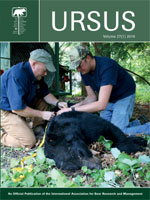Safe and effective but unscheduled drug combinations are needed for wildlife immobilization in some jurisdictions. To this end, we evaluated a combination of nalbuphine HCl (40 mg/mL), medetomidine HCl (10 mg/mL), and azaperone tartrate (10 mg/mL)—referred to as NalMed-A (or NAM)—in 28 American black bears (Ursus americanus), captured during June to August 2014 as part of an ongoing study conducted in and around Durango, Colorado, USA. We effectively immobilized all bears; induction (mean ± SE) was 16.2 ± 0.9 minutes (n = 25) and reversal was 19 ± 1.6 minutes (n = 24). Advantages of NalMed-A included low delivery volume, good sedation quality, and effective reversal. Moreover, NalMed-A does not contain compounds regulated by the U.S. Drug Enforcement Administration, making it a useful unscheduled immobilization combination. Based on these and subsequent field experiences, our dosing recommendations are 0.5–1 mL NalMed-A/45.5 kg estimated body mass (0.44–0.88 mg nalbuphine HCl/kg, 0.11–0.22 mg azaperone tartrate/kg, and 0.11–0.22 mg medetomidine HCl/kg), and 5 mg atipamezole HCl/mg medetomidine for antagonism.
How to translate text using browser tools
1 May 2016
Chemical immobilization in American black bears using a combination of nalbuphine, medetomidine, and azaperone
Lisa L. Wolfe,
Heather E. Johnson,
Mark C. Fisher,
William R. Lance,
David K. Smith,
Michael W. Miller
ACCESS THE FULL ARTICLE

Ursus
Vol. 27 • No. 1
May 2016
Vol. 27 • No. 1
May 2016
American black bear
Atipamezole
azaperone
chemical immobilization
medetomidine
nalbuphine
sedation




